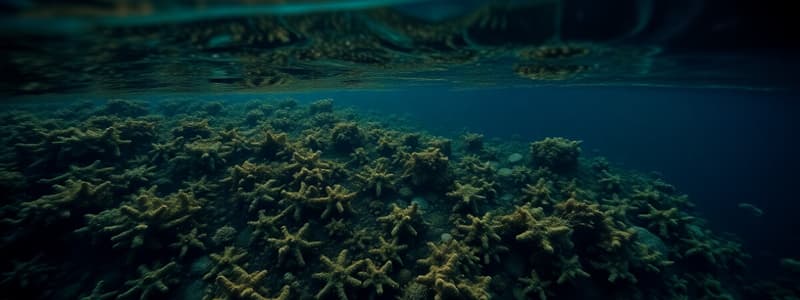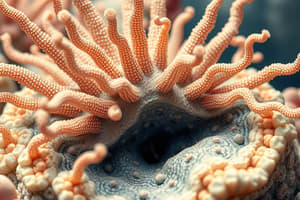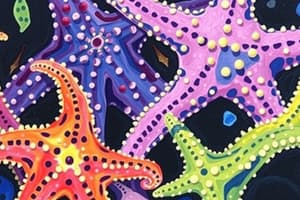Podcast
Questions and Answers
Which of the following is an example of a virus that contributes to the carbon cycle?
Which of the following is an example of a virus that contributes to the carbon cycle?
- Sea star wasting syndrome (correct)
- Black band disease
- Domoic acid
- Phycoerythrin
Which type of protozoa uses pseudopodia for locomotion and feeding?
Which type of protozoa uses pseudopodia for locomotion and feeding?
- Cyanobacteria
- Foraminifera (correct)
- Dinoflagellates
- Diatoms
How do diatoms affect buoyancy?
How do diatoms affect buoyancy?
- Diatoms rely on currents to move through the water column.
- Diatoms store oil and silica, which makes them buoyant. (correct)
- Diatoms release brevotoxin.
- Diatoms have photosynthetic pigments that make them buoyant.
Which of the following is NOT a pigment found in cyanobacteria?
Which of the following is NOT a pigment found in cyanobacteria?
What is the primary function of the blades in a seaweed?
What is the primary function of the blades in a seaweed?
Which type of bacteria is responsible for breaking down decaying matter and contributing to carbon sequestration in the deep ocean?
Which type of bacteria is responsible for breaking down decaying matter and contributing to carbon sequestration in the deep ocean?
How do viruses contribute to the carbon cycle?
How do viruses contribute to the carbon cycle?
Which of the following is NOT a characteristic of dinoflagellates?
Which of the following is NOT a characteristic of dinoflagellates?
What is the primary reason why the Earth's rotation impacts the timing of tides?
What is the primary reason why the Earth's rotation impacts the timing of tides?
What are the primary factors that contribute to the formation of a tidal bore?
What are the primary factors that contribute to the formation of a tidal bore?
What is the main reason why osmosis causes water to move from an area of low solute concentration to an area of high solute concentration?
What is the main reason why osmosis causes water to move from an area of low solute concentration to an area of high solute concentration?
How do sharks maintain osmotic balance with their environment despite excreting salt through their urine?
How do sharks maintain osmotic balance with their environment despite excreting salt through their urine?
How does the sun influence the tides in a way that differs from the moon's influence?
How does the sun influence the tides in a way that differs from the moon's influence?
Which of the following is NOT a stressor faced by organisms living in intertidal zones?
Which of the following is NOT a stressor faced by organisms living in intertidal zones?
What is the primary difference between osmoconformers and osmoregulators?
What is the primary difference between osmoconformers and osmoregulators?
What does it mean when a fish is described as hyporregulating?
What does it mean when a fish is described as hyporregulating?
What is the primary focus of marine biology?
What is the primary focus of marine biology?
What was the initial purpose of early exploratory cruises?
What was the initial purpose of early exploratory cruises?
How did James Cook's cruise contribute to marine science?
How did James Cook's cruise contribute to marine science?
What was one of the main findings of the HMS Challenger?
What was one of the main findings of the HMS Challenger?
Which group of ancient navigators utilized stars and coastlines for navigation?
Which group of ancient navigators utilized stars and coastlines for navigation?
What is the fundamental difference between inductive and deductive reasoning in marine biology?
What is the fundamental difference between inductive and deductive reasoning in marine biology?
What is the sequence of steps in the scientific method?
What is the sequence of steps in the scientific method?
What is the significance of Darwin's trip during his exploration?
What is the significance of Darwin's trip during his exploration?
What occurs at the oxygen minimum layer as depth increases?
What occurs at the oxygen minimum layer as depth increases?
How does temperature affect the speed of sound in water?
How does temperature affect the speed of sound in water?
What is the effect of the Coriolis Effect in the Northern Hemisphere?
What is the effect of the Coriolis Effect in the Northern Hemisphere?
Which of the following describes the concept of the Great Ocean Conveyor Belt?
Which of the following describes the concept of the Great Ocean Conveyor Belt?
What depth must you reach to no longer feel the impact of surface waves?
What depth must you reach to no longer feel the impact of surface waves?
What factors influence the production of wind-generated waves?
What factors influence the production of wind-generated waves?
What defines the difference between stable and unstable water columns?
What defines the difference between stable and unstable water columns?
What happens to the speed of wind-generated waves as wind speed increases?
What happens to the speed of wind-generated waves as wind speed increases?
What distinguishes a manipulative study from an observational study?
What distinguishes a manipulative study from an observational study?
How does salinity influence the density of seawater?
How does salinity influence the density of seawater?
What is the ideal number of replicates in an experiment?
What is the ideal number of replicates in an experiment?
Which of the following is a reason an experiment may need to be revisited?
Which of the following is a reason an experiment may need to be revisited?
What happens to ice at high latitudes in relation to climate?
What happens to ice at high latitudes in relation to climate?
Which property of matter applies to seawater?
Which property of matter applies to seawater?
What does the Rule of Constant Proportions state about seawater composition?
What does the Rule of Constant Proportions state about seawater composition?
Which factor influences turbidity in seawater?
Which factor influences turbidity in seawater?
Flashcards
Marine Biology
Marine Biology
The study of marine life and the interactions within ecosystems.
Subfields of Marine Biology
Subfields of Marine Biology
Areas of study within marine biology including biology, chemistry, physics, geology, and engineering.
James Cook’s Cruise
James Cook’s Cruise
A significant voyage that mapped ocean floors, advancing marine science.
Darwin’s Trip Purpose
Darwin’s Trip Purpose
Signup and view all the flashcards
HMS Challenger
HMS Challenger
Signup and view all the flashcards
First Navigators
First Navigators
Signup and view all the flashcards
Scientific Method Steps
Scientific Method Steps
Signup and view all the flashcards
Inductive vs. Deductive Reasoning
Inductive vs. Deductive Reasoning
Signup and view all the flashcards
Primary Literature Articles
Primary Literature Articles
Signup and view all the flashcards
Observational Study
Observational Study
Signup and view all the flashcards
Manipulative Study
Manipulative Study
Signup and view all the flashcards
Ideal Number of Replicates
Ideal Number of Replicates
Signup and view all the flashcards
Field vs Lab Experiments
Field vs Lab Experiments
Signup and view all the flashcards
Property of Water: Density
Property of Water: Density
Signup and view all the flashcards
Seawater Composition
Seawater Composition
Signup and view all the flashcards
Turbidity Influencing Factors
Turbidity Influencing Factors
Signup and view all the flashcards
Dissolved Oxygen Trend
Dissolved Oxygen Trend
Signup and view all the flashcards
Coriolis Effect
Coriolis Effect
Signup and view all the flashcards
Hadley vs. Ferrel vs. Polar Cells
Hadley vs. Ferrel vs. Polar Cells
Signup and view all the flashcards
Eckman Spiral
Eckman Spiral
Signup and view all the flashcards
Great Ocean Conveyor Belt
Great Ocean Conveyor Belt
Signup and view all the flashcards
Wave Dynamics
Wave Dynamics
Signup and view all the flashcards
Factors Influencing Wind Waves
Factors Influencing Wind Waves
Signup and view all the flashcards
Rogue Wave
Rogue Wave
Signup and view all the flashcards
Particulate Organic Matter (POM)
Particulate Organic Matter (POM)
Signup and view all the flashcards
Dissolved Organic Matter (DOM)
Dissolved Organic Matter (DOM)
Signup and view all the flashcards
Microbial Loop
Microbial Loop
Signup and view all the flashcards
Virus Structure
Virus Structure
Signup and view all the flashcards
Roles of Bacteria in Carbon Cycling
Roles of Bacteria in Carbon Cycling
Signup and view all the flashcards
Cyanobacteria
Cyanobacteria
Signup and view all the flashcards
Red Tide
Red Tide
Signup and view all the flashcards
Protozoa - Foraminifera
Protozoa - Foraminifera
Signup and view all the flashcards
Tidal Forces
Tidal Forces
Signup and view all the flashcards
Spring and Neap Tides
Spring and Neap Tides
Signup and view all the flashcards
Tidal Cycle Duration
Tidal Cycle Duration
Signup and view all the flashcards
Tidal Bore
Tidal Bore
Signup and view all the flashcards
Osmosis
Osmosis
Signup and view all the flashcards
Osmoconformers
Osmoconformers
Signup and view all the flashcards
Salt Excretion in Turtles
Salt Excretion in Turtles
Signup and view all the flashcards
Effect of Temperature on Enzymes
Effect of Temperature on Enzymes
Signup and view all the flashcards
Study Notes
BIO 205 Study Guide Exam 1 - Lecture 1: Introduction
- Marine Biology Definition: Study of marine life and ecosystem interactions
- Marine Biology Subfields: Biology, chemistry, physics, geology, engineering
- Exploration Expansion: Moved from land-based trade and competition to studying marine organisms
- Early Cruise Goals: Navigation and trade, evolving to oceanographic studies
- James Cook's Importance: Advanced marine science through ocean floor mapping
- Darwin's Trip: Initially focused on atolls, plankton, and barnacles, expanded to broader discoveries
- HMS Challenger: Major exploration vessel; initiated significant scientific cruises
- Early Navigators: Phoenicians used stars and coastlines for navigation
- First Marine Station: Naples, Italy
- Sonar Use: Mapping ocean bottoms became heavily used in later years
- Data Collection Equipment: Examples of equipment used for data collection are unspecified
BIO 205 Study Guide Exam 1 - Lecture 2: Scientific Method
- Scientific Method Outline: Question → Hypothesis → Experiment → Results → Conclusion
- Inductive Reasoning Example (Marine Biology): Observing tiger sharks and bluefin tuna having gills and generalizing that all fish have gills, which is incorrect.
- Deductive Reasoning Example (Marine Biology): Establishing a general statement- coral reefs require warm, clear water - and then testing that hypothesis.
- Hypothesis Rejection: If data does not support the hypothesis, revise or propose alternative hypotheses.
- Research Information Sources: Scientific databases and primary literature (peer-reviewed articles)
- Observational vs. Manipulative Studies: Observational studies involve field work, recording natural phenomenon, while manipulative studies control variables in a lab environment. Both methods are used in scientific research.
- Number of Replicates: Ideal number of replicates is 3-10; this can change based on the species or organism.
- Field vs. Lab Experiments: Both have benefits and drawbacks depending on the specifics of the study.
- Hypothesis Proof: Hypotheses are never definitively proved, only supported or not supported by evidence
- Experiment Revision Reasons: Poor design, uncontrolled variables, measurement limitations, or equipment issues
BIO 205 Study Guide Exam 1 - Lecture 3: Unexpected Results
- Properties of Matter: Solid, liquid, gas
- Density and Temperature Impact: Salinity and temperature control the vertical structure of water columns (cooler temps = higher density)
- Trends in Water Column: Varies with latitude
- Ice Floatation: Ice is less dense than liquid water, which affects climate
- Seawater Composition: Average salinity (~35 ppt) and proportions of ions remain consistent.
- Turbidity Factors: Organic and inorganic particles influence turbidity in water
- Oxygen Trend: Oxygen levels generally decrease as depth increases
- Sound and Temperature: Sound velocity decreases as water temperature decreases.
BIO 205 Study Guide Exam 1 - Lecture 4&5: Atmospheric and Oceanic Circulation
- Uneven Heating: Sun's energy varies across latitudes due to Earth's tilt and shape.
- Coriolis Effect & Movements: Earth's rotation influences the direction of air and water currents (e.g., clockwise in Northern Hemisphere)
- Ocean Circulation (e.g. Conveyor Belt): Large-scale movement of water to maintain temperature and nutrient distribution
- Hadley Cells, Ferrell Cells, Polar Cells: Differing planetary-scale weather patterns driven by the Earth's rotation and temperature differences.
BIO 205 Study Guide Exam 1 - Lecture 6: Movement of Water
- Net Water Transport: Driven by various factors including winds and water currents.
- Eckman Spiral: Spiral pattern of water movement driven by wind
- Water Column Stability: Differences in surface and bottom density impact water column stability and mixing.
- Great Ocean Conveyor Belt: Large-scale system of ocean currents across the globe
BIO 205 Study Guide Exam 1 - Lecture 7: Tides
- Tidal Forces: Gravitational and centrifugal forces cause tides.
- Sun's Influence: The sun affects tidal ranges, causing spring and neap tides
- Tidal Cycle Length: Approximately 24 hours and 50 minutes due to the Moon's orbit.
- Tide Chart Use: Understanding high and low tide times and data interpretation.
- Tidal Bore: Temporary flooding caused by a flood tide pushing into a river.
BIO 205 Study Guide Exam 1 - Lecture 8: Microbial World
- Microbial Structure: Passive passing of carbon in the food web and microbial loop
- Microbial Loop: The remineralization of organic matter by microorganisms
- Virus composition: Composed of genetic material, protein, capsid, sometimes collar and tail
BIO 205 Study Guide Exam 1 - Lecture 9: Macroalgae
- Photosynthesis Location: Occurs throughout the thallus, not just the blades
- Algae Body Structure: Different algae species have different body structure designs
- Pigment Determination of Color: Chlorophyll, other pigments determine algae color.
Studying That Suits You
Use AI to generate personalized quizzes and flashcards to suit your learning preferences.




